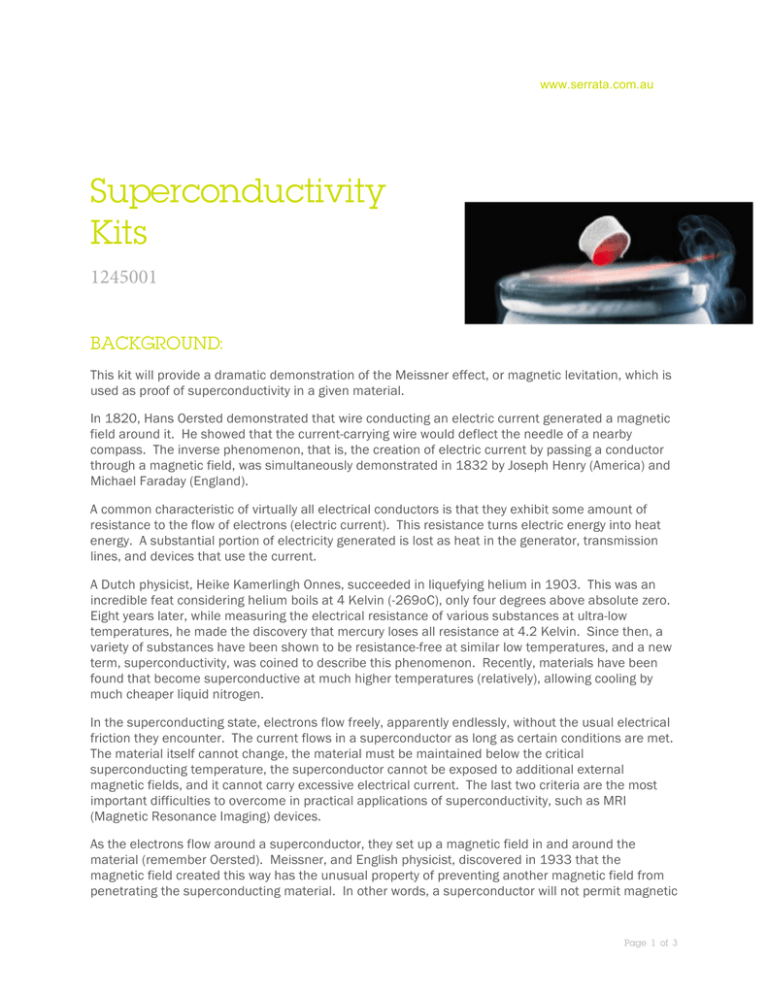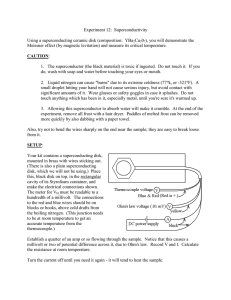Superconductivity Kits
advertisement

www.serrata.com.au Superconductivity Kits 1245001 BACKGROUND: This kit will provide a dramatic demonstration of the Meissner effect, or magnetic levitation, which is used as proof of superconductivity in a given material. In 1820, Hans Oersted demonstrated that wire conducting an electric current generated a magnetic field around it. He showed that the current-carrying wire would deflect the needle of a nearby compass. The inverse phenomenon, that is, the creation of electric current by passing a conductor through a magnetic field, was simultaneously demonstrated in 1832 by Joseph Henry (America) and Michael Faraday (England). A common characteristic of virtually all electrical conductors is that they exhibit some amount of resistance to the flow of electrons (electric current). This resistance turns electric energy into heat energy. A substantial portion of electricity generated is lost as heat in the generator, transmission lines, and devices that use the current. A Dutch physicist, Heike Kamerlingh Onnes, succeeded in liquefying helium in 1903. This was an incredible feat considering helium boils at 4 Kelvin (-269oC), only four degrees above absolute zero. Eight years later, while measuring the electrical resistance of various substances at ultra-low temperatures, he made the discovery that mercury loses all resistance at 4.2 Kelvin. Since then, a variety of substances have been shown to be resistance-free at similar low temperatures, and a new term, superconductivity, was coined to describe this phenomenon. Recently, materials have been found that become superconductive at much higher temperatures (relatively), allowing cooling by much cheaper liquid nitrogen. In the superconducting state, electrons flow freely, apparently endlessly, without the usual electrical friction they encounter. The current flows in a superconductor as long as certain conditions are met. The material itself cannot change, the material must be maintained below the critical superconducting temperature, the superconductor cannot be exposed to additional external magnetic fields, and it cannot carry excessive electrical current. The last two criteria are the most important difficulties to overcome in practical applications of superconductivity, such as MRI (Magnetic Resonance Imaging) devices. As the electrons flow around a superconductor, they set up a magnetic field in and around the material (remember Oersted). Meissner, and English physicist, discovered in 1933 that the magnetic field created this way has the unusual property of preventing another magnetic field from penetrating the superconducting material. In other words, a superconductor will not permit magnetic Page 1 of 3 force lines from another source to enter it and becomes and “anti-magnet”, or more correctly, diamagnetic. It is this property that the Superconductivity Kit dramatically demonstrates. As the superconductor is cooled and reaches critical temperature, the neodymium magnet induces a superconducting current in the disc. This current produces a magnetic field which prevents the magnetic field of the magnet from penetrating. The expulsion of the magnetic field is the force that lifts the superconductor. The Meissner effect is not only a demonstration of the unusual properties of the superconductive state, it is also diagnostic of the state. Many researchers use the Meissner effect to test new materials for superconductivity. At present, it is thought that the superconducting state is the result of the formation of electron pairs (known as Cooper pairs, after the originator of the theory) in the superconducting material. In a normal conductor, electrons flow individually through the crystal lattice (molecular structure) of the conductor and are subject to scattering. The scattering encompasses collisions of the electrons with the lattice structure, impurities or imperfections, and the ions of the lattice itself. This scattering produces heat and the obstruction of the flow of electrons (resistance). In a superconducting material, the theorized pairing of electrons makes them ordered across the lattice and allows them to move across the lattice with no collisions and therefore no resistance. The previously mentioned criteria for maintaining superconductivity must be met, otherwise extra energy will break up the pairs and destroy the superconductive properties. KIT CONTENTS: Economy Kit 1245001 1 Superconductive disc (7/8” x 1/8”) 1 Neodymium magnet (1/8” diam. x 1/8”) 1 low-temperature plastic forceps 1 Petri Dish WARNING: DO NOT HANDLE LIQUID NITROGEN OR THE COOLED SUPERCONDUCTOR OR MAGNET W ITH BARE HANDS OR W ITHOUT EYE PROTECTION. Leather or other non-absorbing gloves are recommended. Cloth gloves can absorb condensation and are dangerous. Use the goggles supplied (in the complete kit) or a chemical splash goggle. SAFETY INFORMATION: The superconducting disc and magnets are fragile – handle cautiously with the provided forceps. Abrupt contact of the magnet with another magnet or metal object may cause cracking and breaking. Particles or powder from a broken magnet could be flammable, so should be kept away from sparks or flames. The superconductive disc can react with and be deteriorated by water. Water will condense as frost on the cooled surface after an experiment – this must be eliminated before storage. To properly dry the disc, allow it to return to room temperature (several minutes), then wipe off moisture with a dry cloth or paper towel. Store the entire kit in a dry area. Page 2 of 3 A special container is required to receive and store liquid nitrogen. If liquid nitrogen is not already available, contact your local bottled gas distributor or university. Use a small-volume transfer container (supplied in the complete kit) for handling the nitrogen during the experiment. Excess nitrogen will be contaminated by oxygen and should not be returned to the storage container. Dispose of any extra liquid nitrogen by slowly pouring on the floor or outside the building away from people – it will rapidly evaporate. ACTIVITIES: To demonstrate the Meissner Effect, you will need one half liter or more of liquid nitrogen. Transfer about one half liter of liquid nitrogen from its storage container to the container. Unpack the contents of the kit. Place the superconducting disc in the center of the Petri dish and slowly pour the liquid nitrogen so that it covers the top of the disc. More liquid nitrogen may need to be added after the initial boiling. Then while wearing gloves and goggles, use the forceps to pick up the magnet and place it gently over the cooled disc. The magnet should be repelled from the surface of the disc. The magnet will continue to hover until the liquid nitrogen boils off and the disc temperature exceeds 92 Kelvin. Remember to dry the disc using the method described earlier before storing the disc. Alternatively, you may place the magnet on the disc prior to cooling it with liquid nitrogen. When the disc reaches its critical temperature, the magnet will levitate. To demonstrate the Meissner Effect to a classroom, use an overhead projector and a mirror. Place the overhead on its back, bracing if necessary, so that the stage is vertical and perpendicular to the work surface. The image will now be projected toward the ceiling. Use the mirror to reflect the image to the desired viewing area and then secure it in place. Arrange the demonstration materials close to the projector stage, adjust for correct focus, and proceed normally. The energy from the overhead will cause the nitrogen to boil faster. Page 3 of 3

